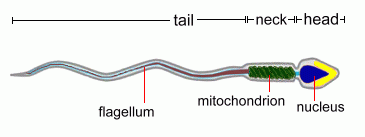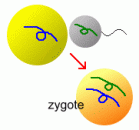 Sperm, or spermatozoa (from the Greek - sperma: seed and zoon: alive) are the male sex cells, or gametes, and are carried in fluid called semen. Sperm are produced in the male testes A sperm cell carries genetic information identical to information in the DNA of of the male from which it comes. It is called a haploid cell because the genetic information is in the form of half-DNA strands, which are ready to combine with the half-strands in an egg it encounters, to produce a zygote, or fertilized egg.  Approximately 200 - 500 million spermatozoa are released in each ejaculation; sperm cells are very tiny (a single sperm is the smallest cell in the body). However, sperm cells make up only about 3% of the volume of semen, a fluid produced by the seminal vesicles and the prostate gland to carry the sperm. Approximately 200 - 500 million spermatozoa are released in each ejaculation; sperm cells are very tiny (a single sperm is the smallest cell in the body). However, sperm cells make up only about 3% of the volume of semen, a fluid produced by the seminal vesicles and the prostate gland to carry the sperm. This seminal fluid contains a many organic and inorganic chemicals, including metal and salt ions, sugars, lipids, hormones, enzymes and amino acids. This fluid provides nutrition and protection for the sperm during their journey through the female reproductive tract, an environment which is actually hazardous to the sperm because of its acidic content and immune response cells.  Mature sperm cells are about 0.05 millimetres long, and are made up of a head, body and tail. The head contains the nucleus, which stores the genetic material from the 23 chromosomes in the cells of the male donor. Attached to the head is the neck, containing the mitochondria that supply the energy for the sperm's activity. The tail is made of protein fibers that contract on opposite sides, producing a propellor-like movement that propels the sperm through the seminal fluid. Sperm swim at a rate of about 3 millimetres per minute, although some sperm cells are better swimmers than others. They have to wave their tails over 200 times a minute to cover those 3 millimetres. Sperm cells are made in the testes; it takes about 72 days to produce a sperm cell. The temperature in the testes is about four degrees below body temperature; that's why they hang outside the body. The scrotum containing the testes helps maintain this temperature by raising or lowering the testicles (in and out of the body cavity) depending on the outside temperature. Over the course of a man's lifetime, his testes will produce more than 12 trillion sperm.
  Sperm become more active when they get close to an egg. They swim faster and their tail movements become more forceful and erratic. This behaviour, called 'hyperactivity', is associated with a sudden influx of calcium into the tails of the sperm. Sperm hyperactivity is necessary for the sperm to be able to break through the physical barriers that protect the egg from fertilization. One barrier is made up of 'cumulus' cells that encase the egg like armor. The second barrier is a thick membrane called the zona pellucida. The zona pellucida allows only sperm from the same species to bind with it when that sperm releases specific enzymes. This allows the sperm to enter the egg, where the sperm fuses with the egg cell's membrane and empties its genetic content into the egg. At this point the membrane of the egg cell changes composition and becomes impenetratable, preventing further fertilization of the ovum. Of the 200 - 500 million sperm released in one ejaculation, just one can reach and fertilize the lone egg released by the female. Sperm can live for only a few hours inside the vagina, and even less than that outside the human body, exposed to the open air. If the sperm survive to enter the less hostile environment of the female reproductive tract beyond the cervix, they can survive for up to five days. The egg, however, has a life-span of only about a single day from the time it leaves the ovary. In short, fertilization can occur whenever a live sperm meets up with a live egg, which can happen even if the sperm are deposited up to five days in advance of ovulation. Sperm in a man's body can be damaged by excessive alcohol intake, or by drug use. Cigarette smoking can lower the number of sperm in semen by up to half, and can also cause impotence. Semen from a disease-free individual is harmless. However, semen can be the carrier for many sexually transmitted diseases, including HIV, the virus that causes AIDS. |
